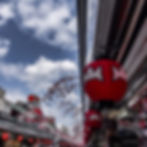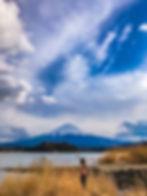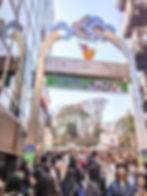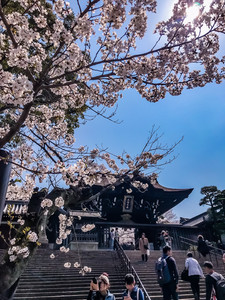Japan is a country where beauty reigns in every corner. Looking at our pictures from Japan never fails to lift my spirits. This place floored me. It's ridiculously crowded yet amazingly organized. It’s really minimal yet equally extravagant. It’s incredibly modern yet rooted in it’s tradition. It’s fragile and wild at the same time.
No matter where you are, you will never be too far from amazing food, sake, and pure zen. It was nothing short of incredible. The entire experience is hard to sum up in words but if I were to try I would say that it is truly an out-of-this-world, fascinating, mind-bogglingly unique and inspiring country in every sense of the word.
ITINERARY
Day 1 - Tokyo City. Part 1.
Day 2 - Day trip to Mount Fuji
Day 3 - Tokyo City. Part 2.
Day 4 - Kyoto - Part 1/2
Day 5 - Kyoto - Part 1
Day 6 - Kyoto - Part 2
Day 7 - Day Trip From Kyoto to Osaka-Nara.
Day 8 - Kyoto to Tokyo Day 9 - Tokyo to Home
TABLE OF CONTENTS
BEST TIME TO VISIT
Japan is beautiful. Period. For a truly otherworldly experience, I recommend visiting during the cherry blossom season* (subject to change every year) but it is mostly from mid to end of March, sometimes running into the first week of April.
FLIGHTS + VISA
We flew nto Tokyo with Emirates but you can also connect through Asia.
Getting a Japanese visa is pretty straightforward - simple paper work and we got the visa in all of 3 days (in Dubai). Latest update as of May, 2023 is that UAE residents can now apply for an e-visa valid for 90 days.
LANGUAGE
Japanese. It helps to know a few words since small store owners don't speak English BUT despite all this, you will never be short of people wanting to help. We actually had one seriously old person going out of his way to walk us to a temple we couldn't find (unasked, he just volunteered - nowhere else have I seen this happen - ever). This place is something else.
CURRENCY Japanese YEN is the official currency. Most places accepted card but I would recommend carrying cash for the metro and buses.
WHERE WE STAYED
In Tokyo, we stayed at the Hotel Monterey Akasaka. The service and the rooms were amazing. It was a short 10 minute walking from the metro station. The best part? All rooms have a cell phone with data that you can take with you during your day out. You won't need to buy a data plan. Now THAT is what I call a great hotel.
In Kyoto, we stayed at a Ryokan for one night and then moved to Sakura Terrace for the remainder of our stay. The Ryokan was cozy and in the middle of the city. The hotel was on the other side of the city but closer to the metro - big rooms and great (but over crowded) breakfast.
COSTS + GETTING AROUND
Japan is not cheap by any means. When we were not walking, we mostly took the metro and the bus to get around in cities. They were on time (duh) and super efficient - just be sure to carry enough loose change.
SAFETY
Hands down one of the safest countries (after Iceland) in the world.
VEGAN + VEGETARIAN FOOD
We decided not to carry any food on this trip since I knew we were mostly going to be in cities and would be in a position to pick up grocery. That being said, there was no shortage of brilliant vegan cafes in Tokyo and Kyoto. Using happycow, we found the most amazing places - small but seriously GOOD. I recommend these must-try places:
Tokyo - T's Tan Tan in Tokyo Metro Station (best vegan ramen in town)
Kyoto - Veggie Cafe (owned by an old man, who was single-handedly rocking it in the kitchen), Falafel Garden, Mominoki House
Osaka - Sangam
HIGHLIGHTS
Day 1 - Tokyo city.
Places covered: Asakusa street, Senso-ji Temple, Tokyo Metropolitan Building, Ueno Park, Choyoda, Imperical Palace
Welcome to Tokyo’s pink and modern world of cherry blossoms. Our first day in this mega modern metropolis was spent shrine hopping and blossom hunting. It’s so easy to forget that Tokyo is so much more than flashing lights, crazy sounds and millions of people. You will be surprised to find that the city is actually home to thousands of temples and shrines, from huge buildings to little temples dotted around the city. The shrines don't just give us a glimpse into the history of Japan but they also act as an antidote to the overwhelming nature of this city.
our first stop was the historical neighborhood of Asakusa. Take a stroll down memory lane as you walk along the narrow pathway with an almost endless array of old stalls selling Japanese treats. Asakusa is famous for its Senso-ji Buddhist temple, one of Tokyo’s oldest temples. You will know how significant it is by looking at the “dramatic” Kaminarimon gate just as you enter the Nakamise-dori.

Pro Tip: After you visit the actual shrine, make sure to check out the vast temple grounds. There are so many little bridges and ponds, and of course the 5-storied Asakusa pagoda.
Our next stop was the beautiful Sumida park for more blossoms and amazing views of the iconic Skytree Tower. It's a huge park and one of the best places for hanami.. much quieter than some of the other parks around the city.
Post lunch, we started making our way through the massive Ueno park - it's a must-see for hoards of trees lined on either side of the path.. great place to do that midday picnic. We spent a good three hours here. The lake in the middle of the park with ducks and framed by the blossoms is a treat to the eyes.
Our last stop for the day was another historical monument - the Imperical Palace.
Day 2 - day trip to Mount Fuji
On our second day, we wanted to escape the city to visit the eternally mysterious Mount Fuji. True to our travel style, we skipped the “tour” and went about exploring the place ourselves.

How to get to Fuji?
Hop on a bus from Tokyo or Shinjuku station to Kawaguchiko station (a ticket costs around 1800 YEN per person). The journey is around 2 and half hours, so I would highly recommend you get an early start if you want to be able spend an entire day at Fuji. When you get off, be sure to make a note of the departure time back from Kawaguchiko to Tokyo.
We added this to our “wish list” despite knowing the blossoms are not going to be in full bloom here until April. In fact, I was skeptical about taking the time to make this trip since there was a good chance we won't get to see the gorgeous mountain due to the unpredictable weather. I read that Mount Fuji loves to play hide and seek... so wasn’t banking on it.
After an early (cloudy) start to the day, we got lucky at around 3 p.m. Wish we had seen more blossoms but still pretty thrilled with the view. After reading so much about people not seeing the elusive mountain after multiple tries, our only thought was we have got to try our luck with this...and the rest was just pure Japanese magic.
Did you know there are actually five Fuji lakes? Lake Kawaguchiko, Lake Yamanakako, Lake Saiko, Lake Shojiko and Lake Motosuko, located at the northern base of Mt. Fuji, which is also one of the best places to view Mt. Fuji from a close distance.

For the best sunset views of Mount Fuji, head to Lake Kawaguchiko. It's a wonderful place to see the mountain in all its splendor, as well as enjoy cherry blossom trees (if you visit during April).
Pro Fuji Tip: as you make your way across the shrine, you will cross a bridge which offers these stunning picture opportunities of the snowy peak on a clear day. We took these pictures just before the sun went down and it was absolutely gorgeous. Walk under the bridge for unobstructed views.
Day 3 - Tokyo city. Places covered Yoyogi Park, Meiji Shrine, Harajuko Street, Shinjuku area, Chiyoda area, Yasukuni shrine, Chidorigafuchi Park
Our third day was spent on the other side of the Tokyo, shrine (and park) hopping in search of the Sakura. The sakura flowers are deeply symbolic. Their short-lived existence showcases the beauty of the fleeting nature of life. During the sakura season, you will see cherry blossom trinkets EVERYWHERE.. from tea cups to cup cakes, to blossom flavored treats.

Tokyo is home to dozens of stunning parks. If you happen to visit during the Cherry Blossom season, you will be spoilt for choice. If you are looking for the best park to catch the blossoms, you can't miss Yoyogi Park. Though this place is right in the middle of urban Tokyo, it is such a quiet place to unwind and relax. Walk around the park to experience the celebratory vibe as locals make the most of the season..
Next up, the iconic symbol in the middle of the city - Meiji Shrine. Right here you will see that this is one of the few countries where the past, present and future co-exist in perfect harmony.

Next we hit the Harajuko street between the Shinjuku and Shibuya lines. This street is famous for it's endless rows of trendy stores and street bites. Be prepared for a serious overdose of hello kitty merchandise.

Post lunch we hit the Chiyoda area where we stopped to visit the Yasukuni shrine at sunset.
Our last stop for the evening was the Chidorigafuchi Park. The garden is famous for being home to over 1300 cherry blossoms.. but the best part is that the blossoms glow at night. Yozakura aka cherry blossoms at night is another amazing way to enjoy hanami.

This was easily the highlight of our day. Though every inch of the park was packed, we could not get enough of the views from here. It was spellbinding with the lake. Unfortunately, given the time of the day, we could not do the boat ride but it's highly recommended (come super early in the day if you want to do the boat ride).
Day 4 - Tokyo to Kyoto by Bullet Train and Ryokan Stay
After a whirlwind 3 nights in Tokyo, we were off to Kyoto for 3 nights, which I felt was just the perfect amount of time to spend in Kyoto.
How to get to Kyoto?
We did not reserve our train tickets in advance. Just went to the Tokyo station and booked a two-way Shinkansen bullet train to Kyoto.
Travel Tip: As soon as you get to the station, you will be welcomed by tonnes of information on day tours and such. Take your pick. We decided to skip this and did it on our own - but if you are pinched for time, these tours are pretty good at covering all the spots around town.
Since it was well past noon when we reached so the rest of the afternoon was spent visiting smaller shrines and immersing ourselves in the culture. Just from the get-go, Kyoto felt so old world and traditional…it was truly a different experience. There were parts of Kyoto that felt like a bustling city, and then you’d wander down a tiny alley and be transported back a 100 years.
There is no better way to do that than with a stay at a ryokan - a traditional Japanese-style inn. It was the much needed escape into the quieter Japanese countryside, to complement days of exploring the crazy busy Tokyo city.
Tip: don't miss the traditional tea ceremony at the ryokan. It's a quick demonstration of one of Japan's oldest traditions - of course, we got to taste the refreshing (read strong) tea after.
Day 5 - Kyoto City
Places covered: Arashiyama Bamboo Forest, The Path of Philosophy, Ginkaku-ji, Yasaka Shring, Chion-In Temple, Fushimi Inari-Taisha
Today was all about doing “touristy” things in Kyoto. We started our day at 6 a.m. and made it to the famous Arashiyama Bamboo forest before the crowd. The forest was much smaller than I had expected but standing amid these soaring stalks of Bamboo was a fabulous experience.
Travel Tip: To get to the forest, take the C6 Bus towards Arashiyama from the Kyoto station. You will be dropped at the bus stop right in front of the forest with clear directions to lead you towards the entrance. ca
Having gone to the Arashiyama Bamboo Forest at dawn, we had seriously amazing views of the place. As someone who loves being outdoors, I just stood there mesmerized by the light making its way through the trees. I mean would you look at this?

I also read that it's best to visit the bamboo grooves in the morning, when it’s slightly windy because the tall bamboo stalks look dreamy and mesmerizing when they rock back and forth.
Our trip to Kyoto was going to be consumed by temples and shrines.. so being surrounded by all the green was already feeling like a great start. It makes you feel as if you stepped into another world... though small, Arashiyama is incredibly peaceful (when there are no tourists around). I highly recommend getting the FIRST bus to the forest if you want good photos of yourself without the crowd.

After we left the Bamboo forest, we took the loop city bus to the Ginkakuji area. We started walking The Path Of Philosophy. A long canal stretches along the path leading to the temple.. it's a wonderful place away from Kyoto city center. It was still pretty early in the day so we thoroughly enjoyed the peace and quiet.
The atmosphere of Ginkakuji temple was just brilliant. While the temple itself was beautiful, the path around the temple is a stunning garden.. it enhanced the feeling of Zen and there was an air of mysticism all around. The rhythm of the small stream in this picture created a peaceful background sound, highlighting the blending of Japanese architecture with its natural surroundings. Don't forget to walk to the top for panoramic view of Kyoto.
No trip to Kyoto is complete without a visit to the Yasaka Shrine and the Chion-in Temple. Both are big and spectacular - expect to spend a few hours here.
Our last stop was the Fushimi Inari Gates. Needless to say, it was way too crowded at 6 in the evening but there are places inside the temple where you can get pictures without 67261292 people around you..
The torii gate is believed to be the division between the physical and spiritual worlds. The best time to visit this stunning shrine is at Twilight. We visited just before sunset, walked around the famous vermilion torii gates and followed the path through the wooded forests to the green Inari mountains.
Day 6 - Kyoto
Place covered - Kiyomizu-dera, Kyoto Gion street, Ryozen Kannon Temple, Nanzenji Stone Garden Temple, To-ji Temple
Our second full day was spent strolling through the backstreets of Kyoto. We truly enjoyed this side of the historical town with its stone-paved cobbled alleys, traditional architecture, and tiled bamboo roofs. We decided to head first to the most iconic temples in Kyoto - the Kiyomizu-dera Temple. The temple is famous for it’s huge veranda which has stunning views of the hillside and Kyoto city. Also known as Pure Water Temple, it is one of Kyoto’s many world heritage sites and one of the most celebrated temples in the country. As you can imagine, the views were otherworldly since we visited at the peak of cherry blossom season.

Next we made our way to this historic Gion area in Kyoto. With it’s picturesque wooden buildings lining the streets, this place is perfect for strolling around and window shopping. I particularly loved the Yasaka Dori street - a lovely, relatively quiet path through the back streets leading to Yasaka Pagoda.
We walked around the Shirakawa-minami Dori, one of Kyoto's most beautiful streets. Then made our way over a small flight of stairs and a cutesy bridge to enjoy a gorgeous and vibrant Kyoto in all its splendor.
If you are in this area, a visit to the Ryozen Kannon Temple is a must. Here we found a 24 meter high statue of goddess of mercy. After this stop, we walked to the Nanzenji Temple. This spacious zen temple is also a stone garden. The garden area is free to explore but you can enter the temple and sub-temple for a small charge. This temple and the surrounding forest is a great way to escape the crowded Kyoto area. Highly recommended.
There was no shortage of amazing places in Kyoto to catch the blossom in all it's glory. Right next to our hotel, we found this beautiful garden. we were the only ones here and boy, were we in for a visual treat.
Our final stop for the day was sunset at the To-ji temple. The 57 meter high Pagoda is like the spiritual center of Kyoto city.
Day 7 - Day trip to Osaka and Nara
Our penultimate day in Japan was spent doing another day trip; this time from Kyoto to Osaka & Nara.
How to get to Osaka and Nara?
Take the Shin-Osaka Train from the Kyoto station. It costs 1420 Yen per person. This train will also take you to Nara.
The Osaka Castle is one of Japan’s most famous castles and features a lot of elements from Japanese castle architecture. Of course, it was the hubs who was fascinated by the architecture. For me, it was about the stunning blossoms. So obviously I clicked the castle with the blossoms in every possible angle.
The port city of Osaka, is Japan’s second largest city and an eclectic one at that. I felt the energy of Osaka was a lot different than that of Tokyo. Yes, there are plenty of historic castles, shopping arcades and quirky streets but the city effortlessly blended modern city life with country charm - which was missing in the bustling Tokyo.

When you think about a castle in Japan, chances are that Osaka’s majestic castle is going to be the first one that comes to your mind but did you know that the Osaka Castle is surrounded by a beautiful park with over 600 cherry blossom trees?
Top Tip: the castle is 600 yen to enter BUT the park is free. If you manage to get here between the end of March and beginning of April - it is one of the most stunning places to see the blossoms in the city.
Did you know that the only thing that stands in the Osaka Castle as it is now and the original castle are these massive rocks? This castle has been rebuilt so many times yet no one can figure out how these rocks got there. Nevertheless, the castle is a massively gorgeous structure and an iconic landmark of the city.
For the second half of the day, we hopped on to the train to visit Nara... famous for it's deer park. These little ones are supposed to be friendly (they are, to some extent) but if you want to pet them be prepared to get head butted in the behind. You can buy snacks to feed them and they oh-so-cutely bow down before nearly biting your hand off.
There is lot more to this place than feeding the deer, of course. The Todaiji-temple is the main attraction here but you can't miss the Isuien Garden. It's like taking a step back in time. The garden is traditionally maintained and on a hot day, it's all the solace you will need.
Day 8 - Kyoto back to Tokyo
We spent our last morning trying to unwind after a hectic trip before heading back to Tokyo for flight back. I recommend a stroll through the Kyoto National Garden (for one final episode of blossom fix). There are lots of places to see inside like the Sensoi Palace,
As we walked back to our room to leave, we happened to stumble onto this jaw-dropping stream. It was the fitting finale to our epic trip. This is truly what Japan was all about - the soul stirring beauty when you least expect to find it.

FINAL THOUGHTS
Japan was so easy to fall in love with. Astounding pink blooms, quirky innovations including but not limited to toilet seats that warm your butt, intriguing culture and some of the kindest people in the world to boot. You can soak in the hustle bustle of Tokyo or jump on the bullet train and hop over to Kyoto. Whatever you choose to do, you will not be disappointed.
We chose the third week of March in the hopes that it would be peak cherry blossom season. Keep in mind that the season is fleeting it's a gamble unless you are going to spend the entire month in the country. Luckily, our timing paid off. This season obviously makes for some of the most strikingly beautiful sights you will ever witness.. so it’s worth braving the crazy seasonal crowd for.
I love so many things about Japan but most of all, I love that this a country of extreme contradictions. From the ancient history to zen temples to mad, mind-boggling quirky cities with insane tech - the country is beyond fascinating.

Want to learn how to earn respect without just taking it for granted? Learn from the Japanese. Probably the only bunch of people I have been absolutely blown away by. Nothing but massive respect. I am literally counting down days until we get to visit this place again. The way everyone and everything is hyper-organized, the people, the delicious food, the tech and of course, their humility... but what I love most is their spirituality. I am not religious and don’t believe in the idea of one superior being. Japan’s unique belief system resonated with me like no other country. I recently read that in Japan no one preaches their belief - it’s simply a way of life. The emphasis is on personal practice and believing in moral principles free of judgement. The best and most important aspect of “Buddhism” is not what you know but about how you practice.

Since this post was all about the blossoms, here are a few fun facts before I end the post. When people think of cherry blossoms in Japan, they assume that there is just one type of spring blossoms.. BUT there are actually over 20 different subspecies. For instance, the most common type of Sakura in Japan is the Somei yoshino or the Yoshino cherry. These five-petaled cherry blossoms are almost white, having only the vaguest hint of pink to them.

The name somei yoshino comes from a village market that existed during the late Edo era, where it is said that these flowers were first sold. Now that I have seen this in person, it’s going to be impossible to think of spring without reminiscing about our time in Japan - with its sea of cherry trees and the perfect pink blooms.
Domo arigato, you beautiful beautiful country.
Drop your comments below and show some love. Feel free to shoot me an email with your feedback.
Cheers,
Anki
To explore more Asian destinations, be sure to check out other blogs for additional insights.




































































































































































































